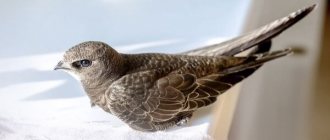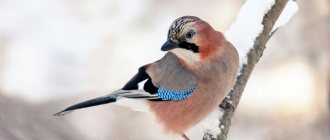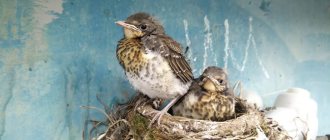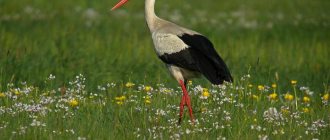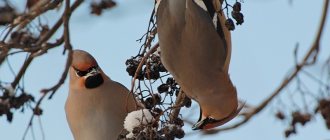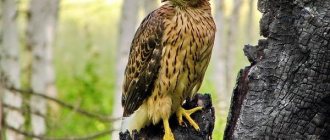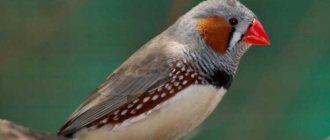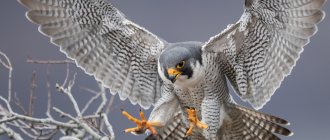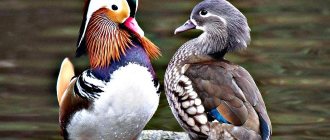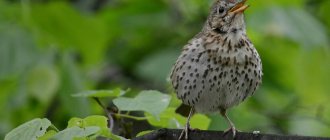Photo: placepic.ru At first glance, swifts resemble swallows, but in reality they do not have much in common. This is a true champion in speed of movement through the air. There are recorded figures of 170 km/h! How do you like these impressive numbers? And if you want to learn more about swifts, this article is especially for you!
general characteristics
The size of swifts ranges from 10 to 25 cm and weighs 50-150 grams. They are considered medium-sized birds and resemble swallows in appearance. They have a fairly large head, dark eyes, a short and fairly sharp beak. The wings of birds are curved and long, but their legs are poorly developed and their size is small. Short legs are anatomically designed to be used to grasp various vertical surfaces. The toes point forward and the claws of swifts are sharp.
Swifts have unique anatomical characteristics that are common to the swiftlet family. They have a lateral “grasping foot” with which they can be attached to various difficult surfaces such as stone walls and chimneys. These places are not accessible to other birds, since they do not have such features.
Typically, swifts have a fairly dark plumage color, with black and gray predominating. Sometimes you can see swifts in which white appears in their color. It is found in the area under the tail, on the throat, near the belly and forehead. The tail feathers are usually forked.
Sexual dimorphism in birds is not pronounced: males and females practically do not differ from each other.
Origin of the species
The black swift, like other species of the swift family, was classified by Carl Linnaeus as a swallow, citing the similarity of foraging for food in flight. In his work “Systems of Nature,” the scientist designated the birds as Hirunso apus, which translated from Greek means “without legs.”
Englishman Colin Harrison and South African ornithologist Richard Brooke analyzed the evolutionary chain based on fossil remains. Behavior, distribution area, and anatomical differences were taken as the basis.
After studying changes in the length and strength of the ulna bones, ornithologists came to different conclusions. Harrison claims that the ancestor of swifts and hummingbirds is the genus of extinct birds Eocypselus; Brook considers the ancestor of Cypseloidinae. Species boundaries remain controversial.
Where do swifts live in the wild?
Swifts can be found on almost every continent. Thus, the common swift, which is considered the most widespread population of birds, lives throughout the territory: from Europe to Asia, from Scandinavia to Africa and the Himalayas. Their habitat is simply huge, and the breeding and migration period extends the geography of their residence to Zimbabwe, Mozambique and Tanzania. In summer, the habitat range extends from Ireland to Siberia.
Among the main countries in which swifts can be found are:
- Spain.
- Portugal.
- Morocco.
- Israel.
- Belgium.
- England.
- Russia.
- France and other European countries.
Common swifts cannot be found in the Indian subcontinent region. Most swifts nest in temperate climates where there are suitable trees on which to build nests. In addition, such zones leave many open spaces where there is an opportunity to search and collect food for future offspring.
At the same time, the habitat of swifts changes to tropical for some time after migrating to Africa. Birds choose areas that have either tall trees or buildings with a lot of open space.
Wintering
For the winter, swifts travel to Africa in mixed flocks. They fly close to each other, reaching speeds of up to 250 km/h. They get to the place quickly, in 4–5 days.
The migration patterns of black swifts were studied by a group of scientists from Sweden led by Suzanne Akesson. Researchers tracked the movements of hundreds of individuals from different European populations for several years and came to the following conclusions:
- the northern populations went for the winter and returned home a month later than the southern ones;
- Lapland swifts migrated to the west of Africa and to the central regions, Italian and Spanish populations, in addition to the central part of the continent, inhabited the southeast of the continent;
- unlike other warm-blooded species, representatives of the northern colonies weigh less than those living in the south;
- small body size makes it easier to endure the hot African climate;
- competition for nesting sites in the southern regions caused an increase in body weight.
The timing of migration depends not only on the length of daylight hours, but also on the weather.
What does a swift eat in the wild?
The main component of the swifts' diet is insects. This largely explains the fact that their diet and lifestyle itself are directly related to climatic conditions. When cold weather sets in, insects are already found, which is why swifts have to migrate to other places in search of food.
Swift hunts a spider
At the moment when the swift is hungry, its body temperature drops to twenty degrees. Most often this happens in winter, since such a drop in temperature usually leads to a kind of hibernation.
In this state, birds can endure about 10 days without food. Even chicks have this adaptive mechanism, which, with the help of “sleep,” wait for their parents to fly long distances in search of food.
Swifts can catch and eat insects while in flight. The beak works like a net that catches prey. Swallowed insects end up in the throat and, with the help of a product secreted by the salivary glands, are glued together into one large ball. This process occurs especially quickly when swifts hunt swarms of insects. One such ball or bolus can consist of 300 insects.
Most often birds hunt:
- Zhukov.
- Aphids.
- Muravyov.
- Os.
- Much.
- Spiders.
Thanks to their high flight speed and skillful maneuvers, it is not difficult for swifts to catch prey. They often hunt near rivers and ponds to catch insects that live near the water.
When birds look for food for their chicks, they deposit the prey in a special throat pouch, from which they then feed the offspring.
Nutrition
The diet of swifts consists exclusively of insects. They catch them with their mouth, which resembles a net. The throat of a swift can accumulate a very large number of insects. Therefore, these birds are considered excellent helpers in the fight against harmful insects.
The change of residence of this bird may depend on the availability of food in the habitat. As soon as there are fewer insects due to weather conditions, the swifts change their place of residence.
Lifestyle and behavioral characteristics
Swifts are quite sociable birds that actively interact with their flock. They nest together, go out hunting and go on seasonal migration. These birds can remain in the air for a long time without the need to land. It often happens that they spend the whole day in flight, and descend to feed their offspring or spend the night.
Common swifts can fly more than 500 km in a day during the nesting period. This indicates great physical strength and endurance, which cannot be found in other birds.
Swift in flight
These birds choose low airspace for migration if the weather conditions are bad: cold weather has set in, high humidity or strong winds prevent movement. If swifts fly high, it means the weather is favorable for long flights.
Elena
Ask a Question
Question to the expert
How long is the lifespan of a swift?
Swifts have a fairly high life expectancy compared to other birds. It ranges from 10 to 20 years.
Social structure
Swifts always maintain contact with each other and live most of their lives in a flock. They communicate using squeals, screams, squeaks, and whistles, which makes these birds quite noisy. When they arrive in the spring after the end of the migration period, the birds strive to find last year’s partner, with whom they built a nest and raised offspring.
Swifts are monogamous birds. They look for a new partner only in two cases: if they do not yet have a formed pair or if their previous partner has died.
After all the pairs have been formed in the spring, the birds begin to look for a place to build nests. If there is no suitable space nearby, they can take away already familiar places from other birds. Sharp claws help them in battles for nesting places.
Swifts can cling to territory even among themselves. Birds fighting each other claw and fall down. Some crash after landing. The winning side begins to build a dwelling on the reclaimed site, using various available materials and saliva, which has good adhesive properties.
Description of the bird
The black swift, 16–17 cm long and weighing 40 g, differs from other species in its dark color without clearly defined areas, except for a vague white spot under the beak. While the plumage of older chicks is pale, that of adults is dark brown, tinged with blue and green.
Age is determined by color saturation. The darker it is, the older the bird. The unusual voice of swifts is manifested in whistling of different tones. Sometimes loud, shrill intonations are heard, a high thin whistle is emitted to attract a partner, and during the migration period there is a period of silence.
Due to the special structure of their visual organs, birds are farsighted and can focus their gaze with either one or two eyes. Life expectancy is 20 years, but some individuals live longer than 25.
Although the peregrine falcon (300 km/h) is considered the record holder for the speed at its peak, it is inferior to the flight speed of the black swift in the horizontal plane. A small bird can reach speeds of up to two hundred kilometers per hour, while a member of the falcon family is only up to one hundred.
If a swift finds itself on the ground, strong legs and long wing feathers help it take off. Having jumped, the bird manages to push off with its outstretched wings.
Swifts' home
Different territories can become nesting sites for swifts. These include hollows of other birds, such as woodpeckers, and artificial areas built by human hands. For example, swifts often make nests in the voids of buildings.
They start construction later than other birds. Usually this moment occurs at the end of April, when the mating season begins. After the couple is formed, both spouses collect materials for the future home.
Question to the expert
How do swifts sleep?
Swifts can sleep not only in nests, like ordinary birds, but also while flying. In addition to the fact that swifts fall asleep on the fly, they can also glide in this way in one place. This happens when the swift gains a height of about three thousand meters. At the same time, it changes direction across to the wind and turns every minute. As a result, the swift flies along a set trajectory, remaining in one place. If there is a moderate wind, this trajectory looks like a circle; if it is strong, then it looks like a square or diamond.
Anything that swifts find becomes such materials: feathers, fluff, grass, small branches, straw, fabric, wool, etc. All this is glued together and forms a structure that resembles a round cup. Its sides are not high, usually they do not exceed one centimeter.
In the wild, swifts like to live at heights: on rocks or in tall trees. Therefore, even in the city they strive to build their nest in the highest place.
A nest being built for the first time is usually not too large. Its diameter is about 9 cm, and the width of the tray is no more than 5 cm. However, gradually the dwelling begins to grow and becomes larger. An improved nest can reach up to 15 cm in diameter with a width of 8 cm. At the same time, the sides also rise to 3 cm.
In urban environments, swifts often place their nests under eaves, on the roof, and in cracks. In the wild, they are usually found on tree branches and sometimes in hollows.
Swift nest on the balcony
Some species of swifts show great vigilance and caution during construction. They strive to camouflage the nest from ill-wishers, preventing other birds from attacking and destroying their home.
Lifestyle
The lifestyle of swifts seems simply fantastic. How can you sleep in the air? But these birds succeed! Moreover, they rest safely for several hours in a row, occasionally flapping their wings. Cases have been recorded when the swift did not land on the ground for more than six months.
What do swifts eat?
The diet of swifts consists of small flying insects. If weather conditions do not allow swifts to find food, they are forced to change their place of residence. When a bird begins to experience hunger, its heat exchange is disrupted, which can lead to “trance sleep.” This feature of the body helps birds survive even a ten-day fast, and thanks to this, chicks survive without food if their parents fly too far.
Reproduction and nesting
The swift tries to nest where no animal or person can reach. It could be a crevice in a sheer rock. However, even within the city limits, a bird can find a place for itself where it can build a nest.
So, they very often like a place under the roof, where only a climber can climb. In parks and forests, the bird uses the tallest trees for this, and its light weight helps it stay in the nest even when the tree sways strongly in the wind.
The swift finds nesting sites near steep cliffs
During nesting time, swifts arrive in small parties. Here, too, a lot depends on the weather.
In some cases, the arrival of a flock of these birds can be seen in April, and in others, after a long and protracted winter, only in mid-May.
The fact is that for normal existence and nesting, swifts require a large amount of food, and therefore the bird waits until most of the insects have already migrated to where the bird is about to fly.
Often flocks of these birds arrive after rains. They have learned to “catch” the cyclone and seem to be riding on its tail.
Thus, the bird’s arrival guarantees the onset of good weather, even for the next few days.
Swifts arrive in small batches during nesting
Almost immediately after arrival, the bird begins nesting. Building a nest can take about 8 days. On average, a swift lays 2-4 eggs.
They are white, without specks, small in size: 17*25 mm. Both parents incubate the eggs, not just the female. Incubation times also depend on the weather.
In good warm weather, 11 days will be enough for complete incubation, and in cold weather these periods will extend to 16 days.
If it starts to rain and the temperature outside drops, the bird has to spend a lot of time looking for insects for food, and then there is much less time left for incubation.
If the bird remains hungry to incubate eggs in the nest, then this will be of little use, because its body does not produce a sufficient amount of heat without food.
If the search for food gets really bad, then the swifts completely relieve themselves of nesting worries. In this case, they throw the eggs out of the nest, even if there are only a couple of days left until the end of incubation.
As soon as the chicks hatch, they spend the first time in the nest. These terms may vary and depend on many factors. On average, they fly out of the nest on the 38th day of life, and sometimes a little earlier.
If it rains constantly outside, and in general the weather is not favorable to flights, small swifts can sit in the nest for 56 days. All this time, parents feed their babies, often flying to the nest.
They bring with them a “bag” of food in their beak - some kind of insect. During the day, an adult bird can fly to the nest to feed its chicks 30-40 times.
At the same time, an adult swift does not fly up to babies with one insect. The bird learned to “hoard” them, collecting them in its beak and gluing them with sticky saliva.
In each such “gastronomic bag” a bird can bring 400-1500 insects.
Thus, in good weather, the chicks receive about 40,000 insects per day. Photos of adult swifts feeding their chicks evoke tenderness and admiration among many.
The swift glues its nest together with saliva, which hardens very quickly
If the weather is bad, then adult swifts sometimes have to travel long distances in order to get food for themselves and their children. This distance can be measured in tens of kilometers.
Of course, having flown 60-70 km for food, parents cannot constantly return back to feed their chicks. During this period, the chicks fall into torpor, which helps them hold out until their parents arrive.
After the chick flies out of the nest, it is already able to look for food for itself. This often happens when the parents once again go in search of food. This is how the swift’s adult life begins.
Family life
These birds always build their nests very high and away from people. That is, so that during their absence the chicks are as safe as possible. Ideal for them is a mountain gorge. And within the city there is a hole between the roof and the wall, where people and other animals cannot climb.
If swifts choose a park or forest as their home, then the oldest and most branched tree that can withstand gusts of wind without strong swaying will be chosen. But even with strong gusts of wind, they hold on well with the help of sharp claws.
Offspring
The female usually lays 2 eggs, with rare exceptions there may be more. The eggs are elongated, whitish in color, length - 2.6 cm, width - 1.6 cm. The female incubates the eggs, and the male feeds her at this time.
Hatched chicks need food. Both parents take care of the offspring. During one visit of the parent, only one chick receives food.
Birds eat small and other insects. The male does not swallow the small ones one at a time, but collects them in his beak until they turn into a lump along with saliva. Only when the lump is ready does the swift swallow it or carry it to the swiftlets. Swifts are voracious, they kill a lot of insects, but most of them do not benefit humans.
Under the influence of external factors, when it becomes cool outside, the chicks’ body temperature may drop: 2-3ᵒ C above atmospheric. This state of absolute hunger can last 5-10 days. During this period, the shearer's body feeds on accumulated fat deposits.
Lifespan
The fastest bird in the world is the peregrine falcon (a type of falcon). Its limit is 300 km/h. But we are talking about dive speed, that is, movement from top to bottom, while the peregrine falcon makes horizontal flight no faster than 100 km/h, so in this sense, the needle-tailed swift is an absolute record holder!
It is said that the tower swift can spend years in the sky, resting, feeding and even mating on the fly. In fact, this information is somewhat exaggerated, although the reality is indeed impressive.
Thus, Swedish scientists (Lund University) installed special sensors on several dozen birds, and a few years later, having caught 19 individuals from the control group, analyzed the information received and published the results of the experiment in the journal Current Biology.
It turns out that during the year, black swifts behave like any other bird during the nesting period for two months, but the rest of the time they spend no more than 1% of their time out of flight.
Going to warm regions in August, the birds can next touch the ground only ten months later, having already returned to their homeland, while some individuals sometimes sit on tree branches during wintering, but, in principle, they do not feel any particular need for this.
Scientists have calculated that the tower swift can cover a distance equal to seven flights to the moon (meaning a round trip) during its life!
Oddly enough, the life of a black swift, so complex in terms of energy costs, is not so short. On average, birds live from seven to ten years, but there are cases when some individuals reached the “honorable” age of 20 years (the recorded record is 21 years).
The main enemies of birds
In nature, such an excellent flyer as the black swift has practically no enemies . However, swifts are hosts of specific parasites - cavity mites, which can cause quite serious diseases in both young birds and adult birds.
At the end of the nineteenth century, massive destruction of black swift nests was observed in Southern Europe. This situation was due to the popularity of the meat of the chicks of this species, which was considered a delicacy. Sometimes swifts, especially sick ones, become easy prey for birds of prey and cats.
Quite a large number of individuals die as a result of accidental collisions with wires on power lines.
How do swifts sleep?
In addition to the fact that the bird sleeps in flight, it manages to glide in one place in its sleep. Ornithologists at a university in Sweden have found out why this happens. As a result of radar and observations, the following patterns were revealed:
- Before going to bed, the swift gains a high altitude of about 3 thousand meters;
- changes its direction across to the wind, turning every 50-60 seconds.
Thanks to this method, the bird simply flies along a certain trajectory in one place. If the wind is moderate or weak, then the trajectory resembles a circle, if strong, then a diamond or square.
Wintering and lifestyle
The swift is a bird that prefers to spend the winter in warm regions, and with the onset of warm weather it always returns to its homeland. Swifts are loud and noisy; they like to fly not alone, but in flocks. Birds spend most of their lives in flight. They flap their wings frequently and fly quickly. The peculiarity of the species is the ability to perform gliding flights. When the weather permits, the birds compete with each other in the air, making sharp turns and emitting a loud cry.
The black swift is a species whose characteristic feature is the inability to walk on the ground. However, they can cling to sheer rocks and vertical walls thanks to their strong and strong paws.
Character and habits of swifts
Despite the fact that swifts are mostly migratory birds, there are also sedentary species among them. However, the characters of birds are mostly the same: they are energetic, active, they have an excellent metabolism and a good appetite. Swifts are distinguished by developed organs of hearing and vision.
Their colonies can number up to several thousand pairs. Despite living in large families, swifts do not have the most peaceful character. They are cocky and pugnacious. They willingly start quarrels both with representatives of their own species and with other birds. At the same time, swifts are not distinguished by great intelligence and cunning. They take with physical strength and dexterity rather than with prudence.
Most swifts are extremely hot-tempered. Because of this, they lose their vigilance and forget about their safety.
These birds are highly dependent on weather changes. If cold weather comes immediately after warm days, their body has a hard time adapting to it. As a result, a kind of hibernation mechanism is triggered, with the help of which they get used to temperature changes.
Swifts' nests are not as neat as those of other birds. They use a bunch of building material, which they quickly glue together, without worrying about the reliability and safety of the nest.
Interesting facts about the bird
Features of the structure and behavior of black swifts:
- Dense feathers over the eyes protect the visual organs from insects during flight.
- In inclement weather, parents cannot feed their offspring. During this time (up to 12 days) the chicks fall into torpor, saving nutrient reserves.
- At one time, each parent is capable of bringing a brood of up to 1 thousand insects.
- During the entire period of feeding the offspring, the female and the male fly a distance greater than the length of the equator.
- Two-month-old young animals can feed on their own and sleep on the fly.
- People say that swifts return from Africa on the “back of a cyclone,” bringing warmth with them.
The decline in the population of the species of the swift family is associated with mass extermination in the 19th century due to the prevailing belief that eggs and poultry meat can cure a number of diseases.
Reproduction and raising of offspring
Swifts can nest in any environment: from small towns to mountains and deserts. They collect building elements for the nest mainly on the fly. From the ground, like other birds, swifts rarely pick up building material. The couple formed by the end of April arranges their home in about a week. Some birds return to a nest that was built last year. These birds have a very good memory, so they easily return to their previous home.
Females usually lay no more than 2 eggs per mating season. The eggs themselves are usually white. It takes about three weeks to incubate them, during which the male gets food not only for himself, but also for his wife, who is unable to leave the nest anywhere.
Swift eggs
The duration of incubation of eggs depends mainly on weather conditions and food obtained by the male. As soon as the chicks are born, the parents protect them and feed them for a month and a half. The duration of this period is also related to the weather. Under good, warm conditions, the chicks grow and develop quite quickly. If the spring turns out to be cool, this affects the amount of available food, which indirectly affects the later maturation of the chicks.
Caring for the Cubs
Although most swifts lay 2 eggs, black swifts can lay up to 4 eggs. A small number of chicks ensures better survival of the offspring. The female incubates the eggs for at least two weeks, while the male looks for food for the pair. Newborns are born very weak. Swifts are very caring parents who protect their chicks from external dangers and never leave them hungry. Typically, feeding occurs with the help of compressed lumps consisting of saliva and collected insects.
Parents nurse for about 40 days, during which the offspring gradually grow stronger, learn to fly, and then leave the nest.
Habitats
This species of bird makes migratory flights. In the summer, they settle in large numbers in Western Siberia, China and so on to Spain. In the northern part of the planet, swifts choose Finland, Norway and the subarctic zones of Russia as nesting places.
Black swifts breed their offspring in the southern territories:
- Algeria;
- Israel;
- Lebanon;
- Morocco:
- Near East.
Birds winter in southern Africa, as well as on the equator. They live most comfortably there.
Natural enemies of swifts
Adult swifts have quite a few natural enemies, which is due to their high flight speed. Other birds simply cannot compete with swifts due to their extremely fast movements. Therefore, people do not often record attacks on these birds by other birds. In addition, swifts know how to strategically place their nests away from prying eyes. The high altitude and camouflage of the nest helps protect the offspring from attacks by predators that walk on the ground.
The location of the nests in the recesses helps to hide them from prying eyes, and the dark skin of the chicks and their feathers become an excellent camouflage for the babies themselves.
Special protective mechanisms, resulting from evolutionary adaptation, help swifts avoid most natural predators. Among the small number of birds that are hostile to swifts are:
- Yastrebov.
- Cheglokov.
- Common buzzards.
These are birds of prey that hunt smaller birds. Most often, attacks occur not on adults, but on newborn offspring or even on chicks that have not yet hatched from eggs.
A separate problem exists for black swifts, which are more endangered than others due to the harsh climate and weather conditions. The location of the nest in places characterized by high humidity creates a great danger for the chicks. It is due to the fact that babies can accidentally fly out of the nest ahead of time or fall, since the sides there are almost completely absent. If this happens, the chicks may be injured, and their feathers, due to falling into the water, will become heavier, and it will be more difficult for them to move.
Speed record holder
Black swifts are the fastest and very hardy birds . The average horizontal flight speed of an adult swift is often 110-120 km/h or more, which is almost twice the flight speed of a swallow. Such speed of movement was reflected in the appearance of the bird. The eyes of the black swift are covered with short but very dense feathers, which play the role of a kind of “eyelashes” that provide the bird with good protection in the air when colliding with any flying insects.
Return to content
